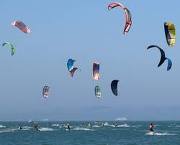 For hundreds of years and in many Asian nations, the “original” kite sport of kite fighting has been practiced by children and adults. Aerial combat with kites is practiced in a large variety of ways: Royal sport of the pak pao and chula in Thailand, one-on-one tangles of patang in India, large Shirone and Ajikata kites engaged in combat and then destroyed in a tug-of-war, of the wickedly fast flying of Korean fighters. A common form of the sport as practiced in Afganistan is well described in Khalid Hosseini’s The Kite Runner.
For hundreds of years and in many Asian nations, the “original” kite sport of kite fighting has been practiced by children and adults. Aerial combat with kites is practiced in a large variety of ways: Royal sport of the pak pao and chula in Thailand, one-on-one tangles of patang in India, large Shirone and Ajikata kites engaged in combat and then destroyed in a tug-of-war, of the wickedly fast flying of Korean fighters. A common form of the sport as practiced in Afganistan is well described in Khalid Hosseini’s The Kite Runner.
The advent in the 1970s and 1980s of two-line, maneuverable kites led to the large movement of sport kiting. Sport kite flyers flew precision maneuvers and routines choreographed to music and were judged much like skaters or dancers. In these decades, many more people were introduced to kites through sport kites than through traditional single-line “recreational” kites.
The final step in the sport evolution occurred when two- and then four-line kites were made specifically for traction power. First, ground-based kite buggying began through the efforts of Peter Lynn of New Zealand. Soon after, traction fans took to the water and the efforts of Bruno Leganiaux, Corey Rosseler, and others led to the first kite surfers. The sport of kite boarding has experienced growth much like its predecessor wind surfing. It is a hugely popular sport featuring high jumps, aerial tricks, speed and power.
Racing yachts have experimented with kite spinnakers and this could indeed be the next step in kite sports.

